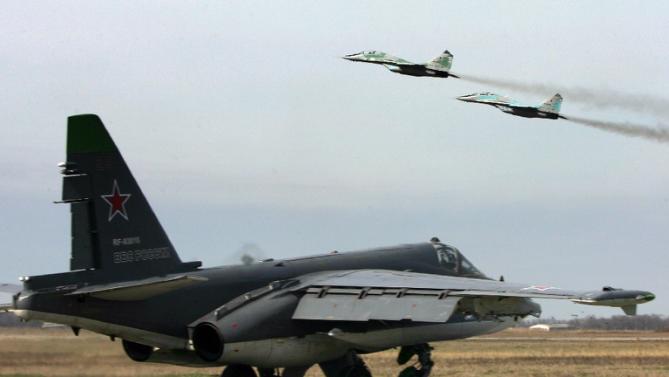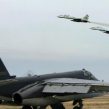
Russian Memories of Soviet-Afghanistan Conflict Cloud Syria Operation
Publication: Eurasia Daily Monitor Volume: 12 Issue: 189
By:

More than 25 years after the Soviet Army withdrew from Afghanistan, Russia is engaged in an out-of-area operation beyond its frontiers. The Kremlin’s message alleges the air campaign is restricted to combatting the Islamic State in Syria though most of the sorties carry out strikes on the rebel opposition. However, the Kremlin has been clear that the campaign itself will be “temporary,” though this has been contradicted by top brass statements about the number of sorties reaching 300 daily at some point, and others indicating the future emergence of a “massive” air, land and sea military basing presence in Syria (Komsomolskaya Pravda, October 18). Nonetheless, among Russian defense and security specialists, there are certainly signs of unease concerning the Kremlin’s foray into the Middle East and widespread concern about its objectives and even the timescale of the air operations in support of Bashar al-Assad’s forces.
Beyond Russian officialdom and the tightly controlled state media evidently intent on boosting the popularity of the military intervention in Syria’s civil war, experts debate and criticize the campaign across a wide range of issues and potential risks; one common theme is the national memory of Afghanistan and the risk of being drawn into an unwinnable war. Yet, the complexity of the operational environment is acknowledged in Russian experts’ discourse, as well as the difficulties in conducting such military operations far from Russia’s borders. Security scholar Alexei Arbatov considers that the intervention in Syria may be risky, though he sees no link between the war-torn eastern Ukrainian region of Donbas and the operation to prop up al-Assad. Russian President Vladimir Putin, in his view, genuinely presented an alternative approach and possible means of cooperation with the United States, which had not been possible in Ukraine. Arbatov implies that the main “geopolitical” risk is that the US and Russia now operate parallel but quite different air campaigns in Syria (Kommersant, October 12).
Mikhail Khodarenok, the editor of Voyenno Promyshlennyy Kuryer and a member of the Moscow-based Council on Foreign and Defense Policy (SVOP), points to the difficulty in Russia’s military strategy as rooted in the condition of al-Assad’s armed forces: it is an unclear structure, with limited resources and riddled with internal contradictions. Moreover, it is an endlessly beaten army that has not tasted military victory. Khodarenok believes. “It will probably be rather difficult for them [al-Assad’s forces] to achieve any tangible operational results, and in addition to all this, offensive operations in urban conditions with dense built-up areas will lead to extremely palpable human losses in any scenario” (Moskovskiy Komsomolets, October 8).
Risks also exist for the Russian operation linked to targeting and the potential strength of rebel forces. Military expert Colonel (retired) Viktor Murakhovskiy sees the Syrian Army’s main targets as the cities of Homs and Hama: “[T]he SAR [Syrian Arab Republic] Army would significantly improve its position [by capturing these two enclaves]. Of course, there is no question of a large-scale operation, only tactical tasks [that, when achieved, would allow] the Syrian Army [to] take full control of the country’s industrially developed west.” Murakhovskiy also points to the risk of friendly-fire incidents with Russian airpower attacking Syrian positions during ground offensives. Moreover, Murakhovskiy is convinced that a rebel counteroffensive will be bloody, as they will not flee from their positions, but will manage to organize a serious defense (Moskovskiy Komsomolets, October 8).
Dmitry Trenin, the Director of the Carnegie Moscow Center, argues that President Putin has engaged in a gamble in Syria that goes far beyond the country itself, presenting both opportunities and risks for Moscow in the Middle East. Trenin sees the military intervention as Russia’s first “US-style” war in which air strikes characterize a “no-contact” approach to warfare and reduce the risk of Russian causalities. In his view, commencing with the seizure of Crimea in March 2014, Russia has broken out of the post–Cold War world order, and engaged in differing types of conflict in Donbas and Syria to demonstrate this new reality. Trenin sees Moscow’s military strategy as aiming to soften up al-Assad’s enemies to enable an effective offensive, though he argues: “Complete military victory for Assad, however, is impossible, and the Russians know it. Military success is only worth as much as can be translated into political leverage at the negotiating table” (Tabletmag.com, October 13).
The formidable challenges and risks facing the Russian military campaign, in the views of Russian defense specialists appear to hinge on the memory of the Afghanistan War; if Moscow becomes further drawn into the conflict marked by sending in larger numbers of Ground Forces, an “Afghan scenario” is the main danger. Navigating this risk will demand a political-military balancing act, which may prove more difficult the longer the campaign continues. Some experts see the main risks stemming from the air war becoming long and drawn out (with limited or no real value added on the ground) or avoiding military confrontation with Western powers. Others note the difficulty in finally finding a way to end the operation itself (Livejournal, October 8).
Khodarenok ties concerns about the security of the airbase in Latakia and other Russian facilities to the Soviet experience in Afghanistan. Force protection, in his view, must address the vulnerability of air assets during take-off and landing, the question of protective shelters at the Latakia base, and, indeed, how these platforms are used in operations. To date, most fixed-wing missions appear restricted to high altitudes and, despite claims to the contrary, use mostly unguided munitions. Questions also persist about the value of intelligence provided by Damascus, whose vested interest is to keep Russia in the conflict for ongoing support, in addition to the relatively small number of sorties compared to the US-led efforts against the Islamic State (Voyenno Promyshlennyy Kuryer, October 5).
Khodarenok also rightly highlights the supply and logistics challenges of the operation, since traditionally Russian military campaigns are heavily tied to the use of railways to move hardware, forces and supplies. The question of strategy remains equally unanswered, as the Kremlin’s approach to Syria leaves this unclear. Khodarenok cites the Soviet strategist Alexander Svechin, who noted that strategy is not unlike politics, in that often a chicken will hatch ducklings: in other words, consequences are not all similar to their causes (Voyenno Promyshlennyy Kuryer, September 30). While the fear of falling into an “Afghan scenario” may limit Russian planning, the unpredictable risks of second- and third-order consequences may undermine the domestic popularity of the conflict.




